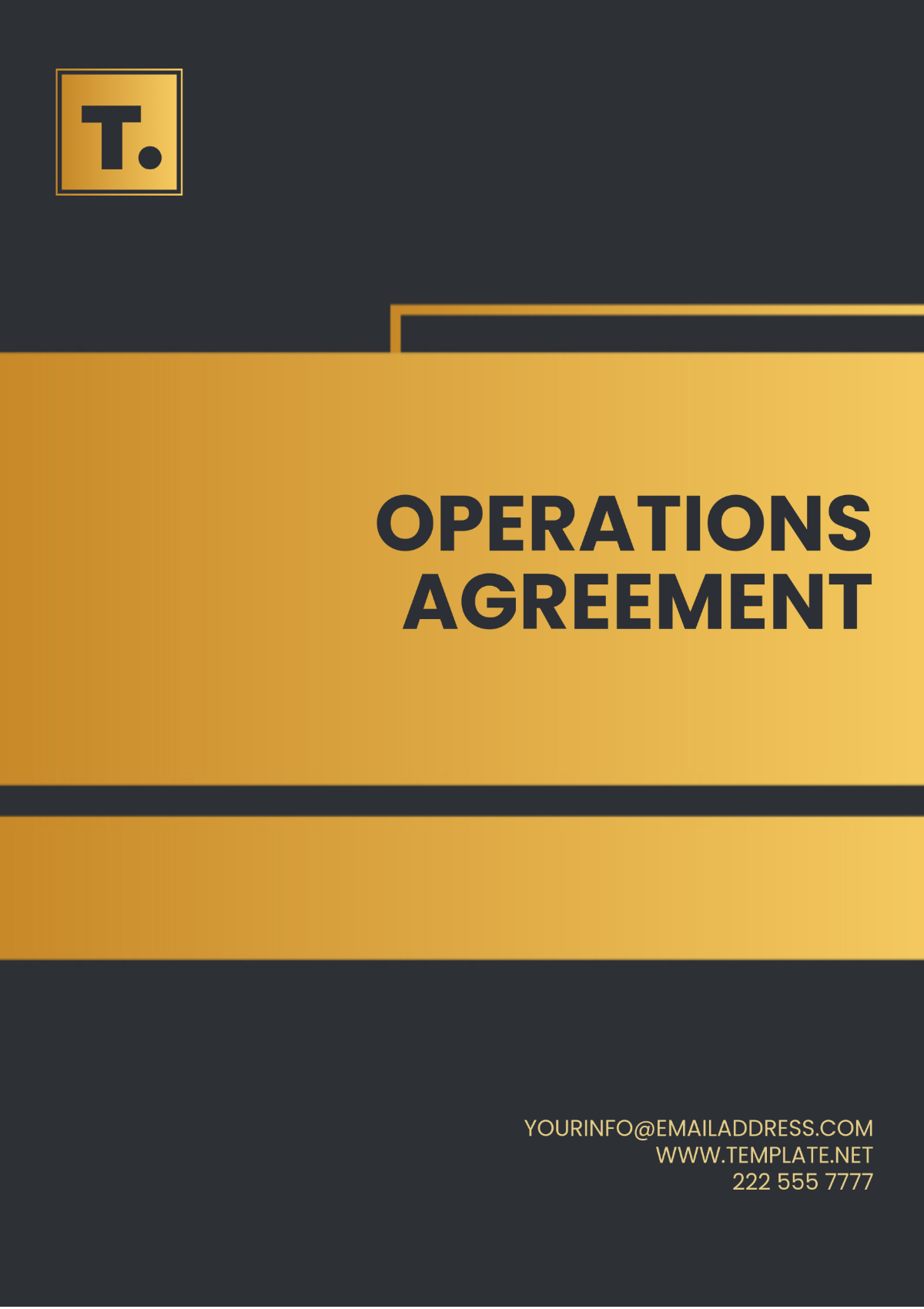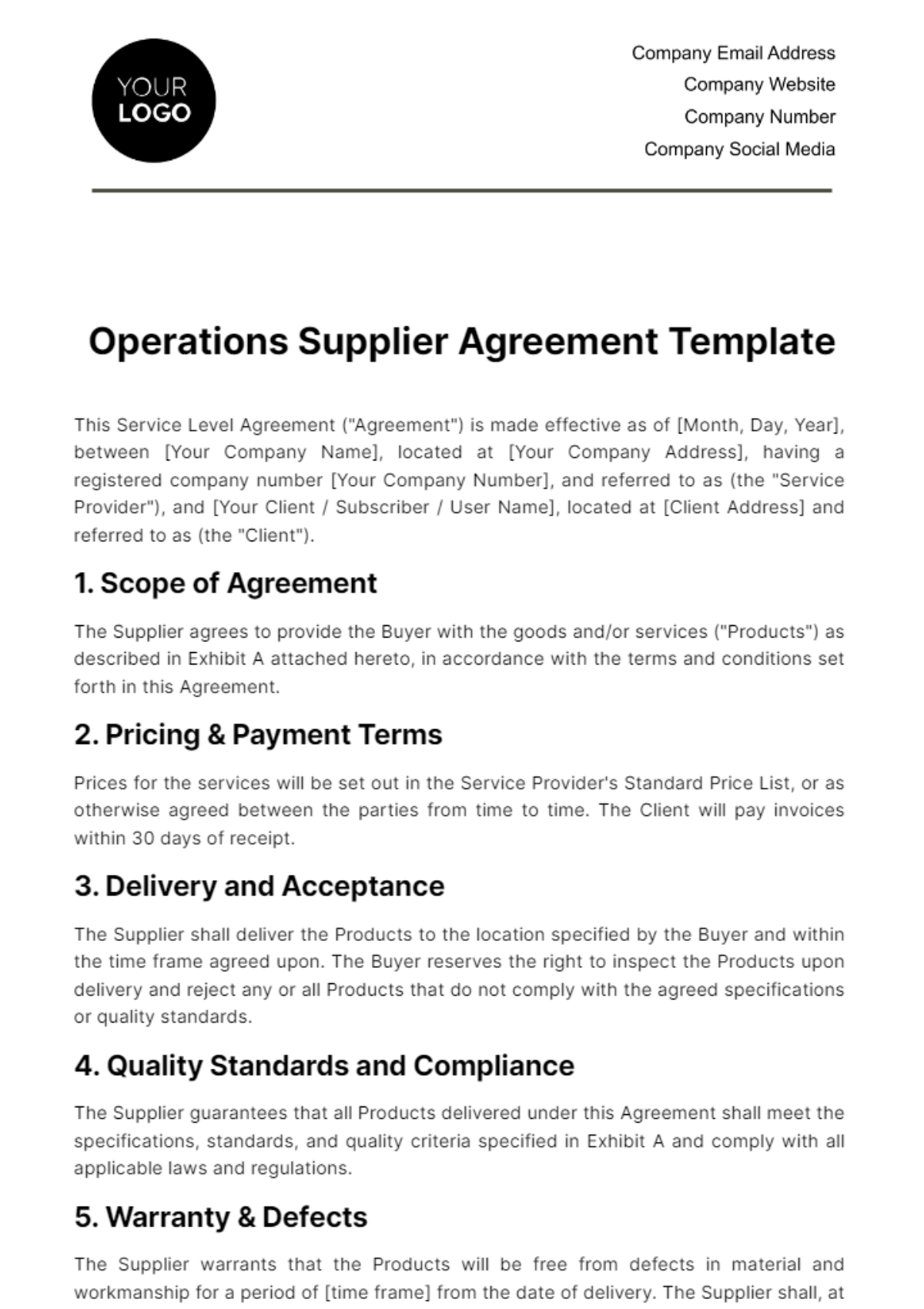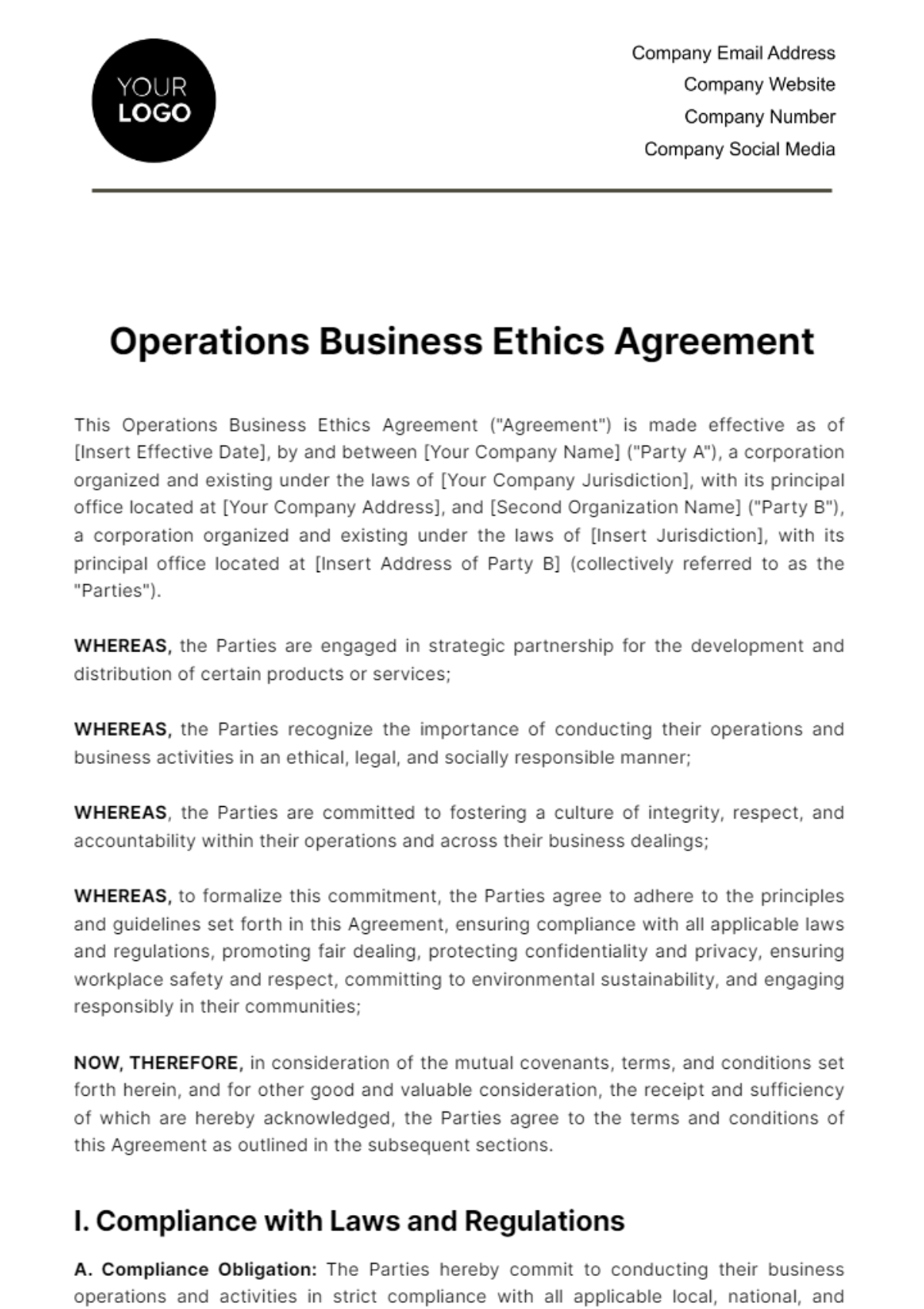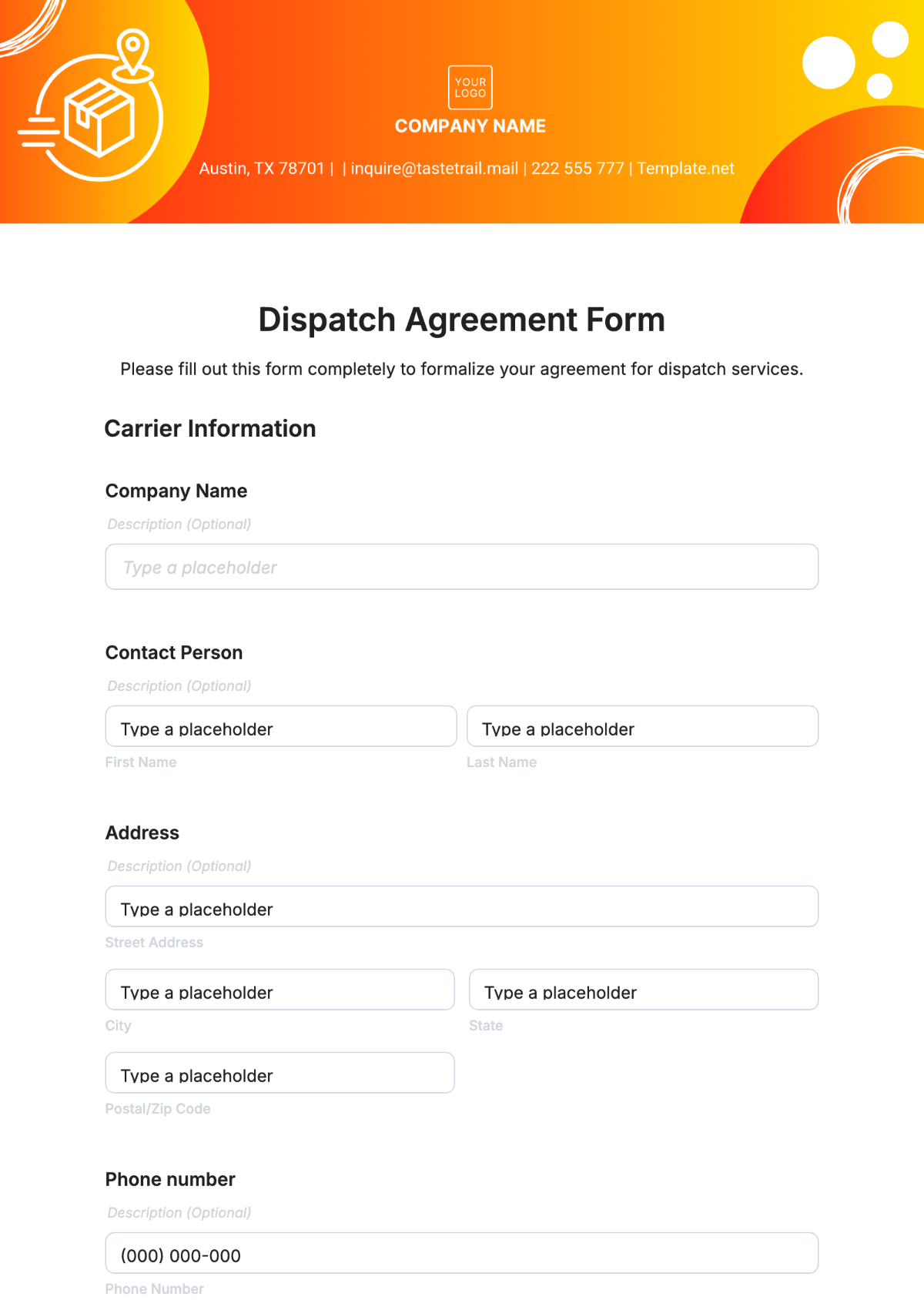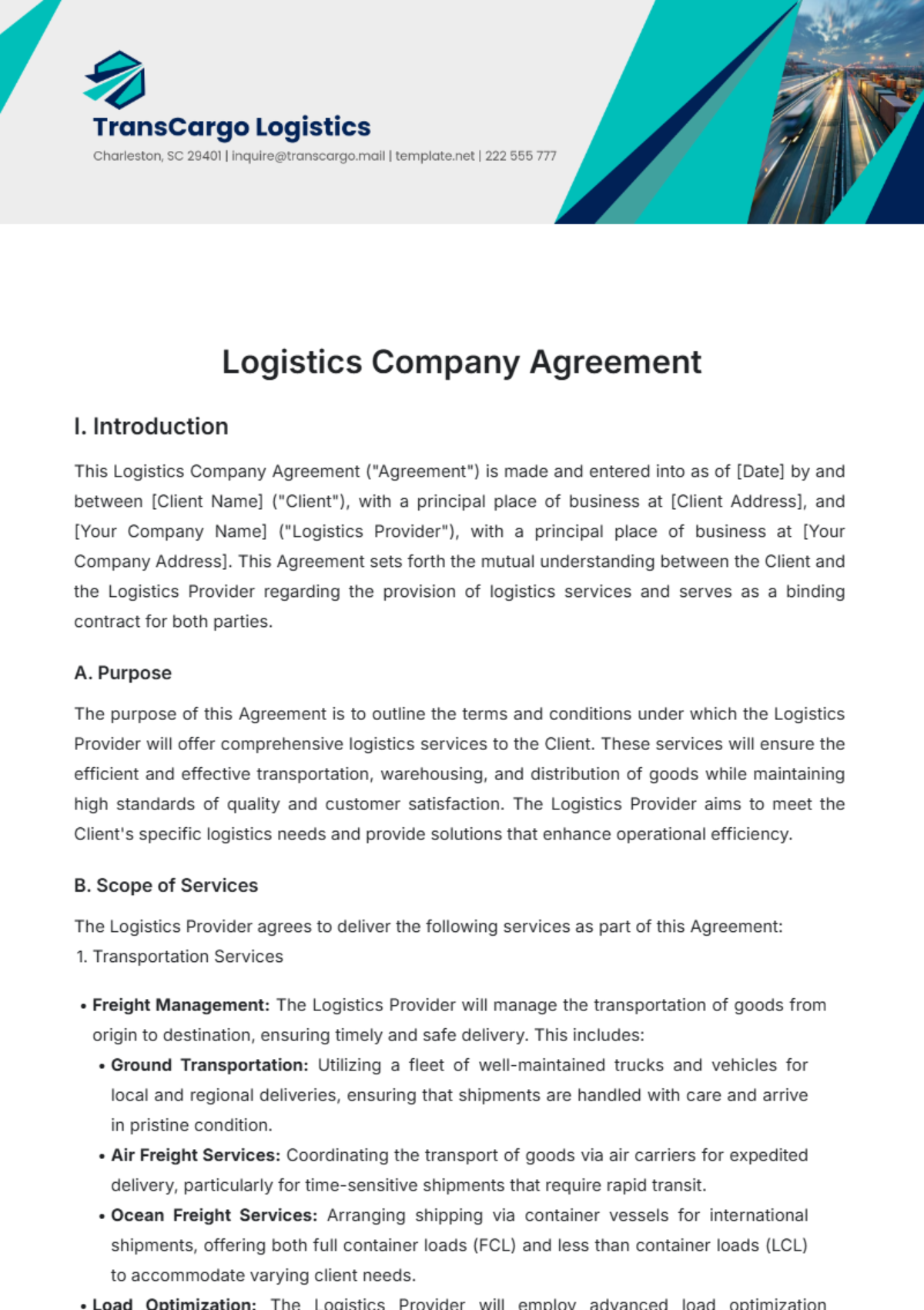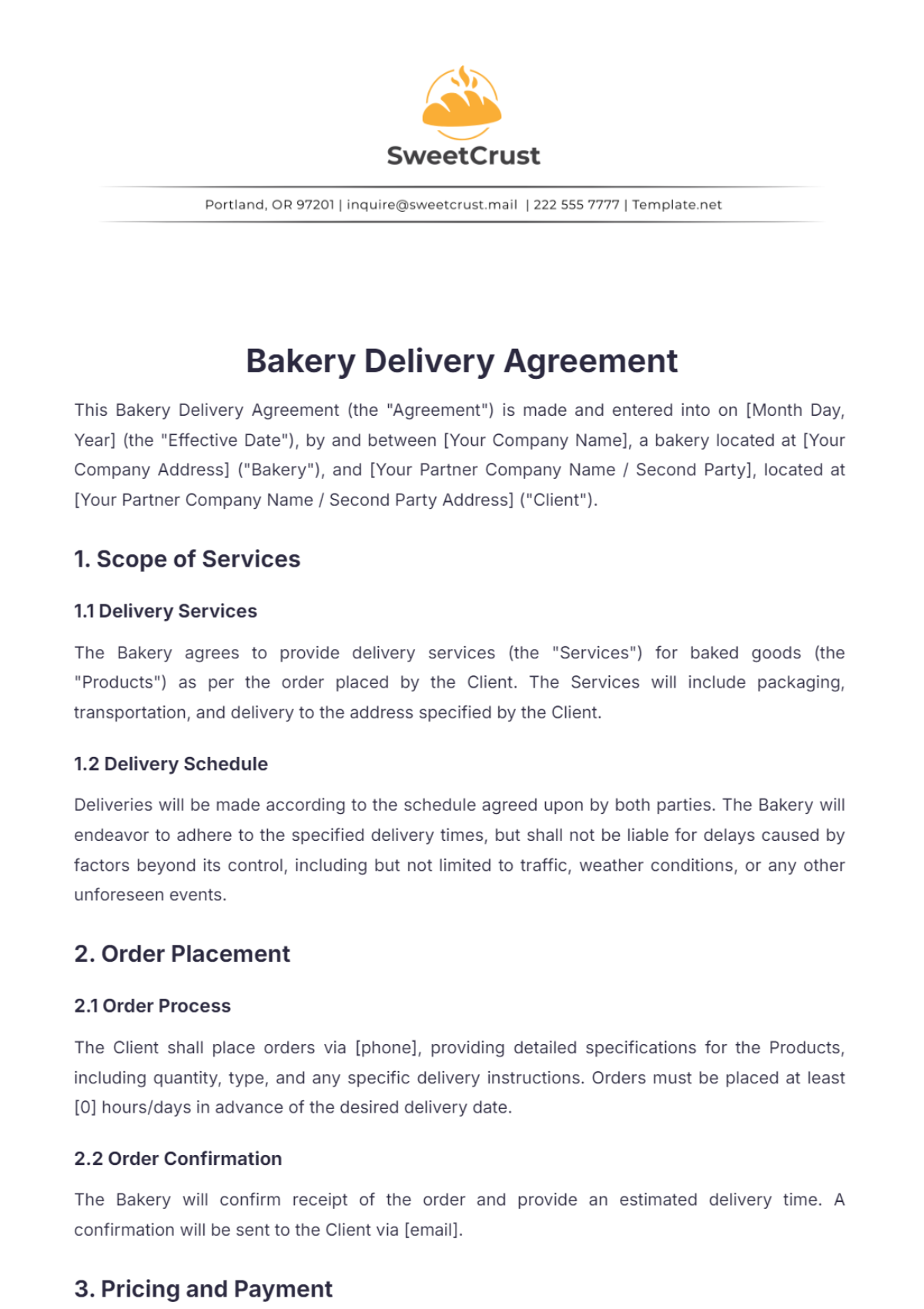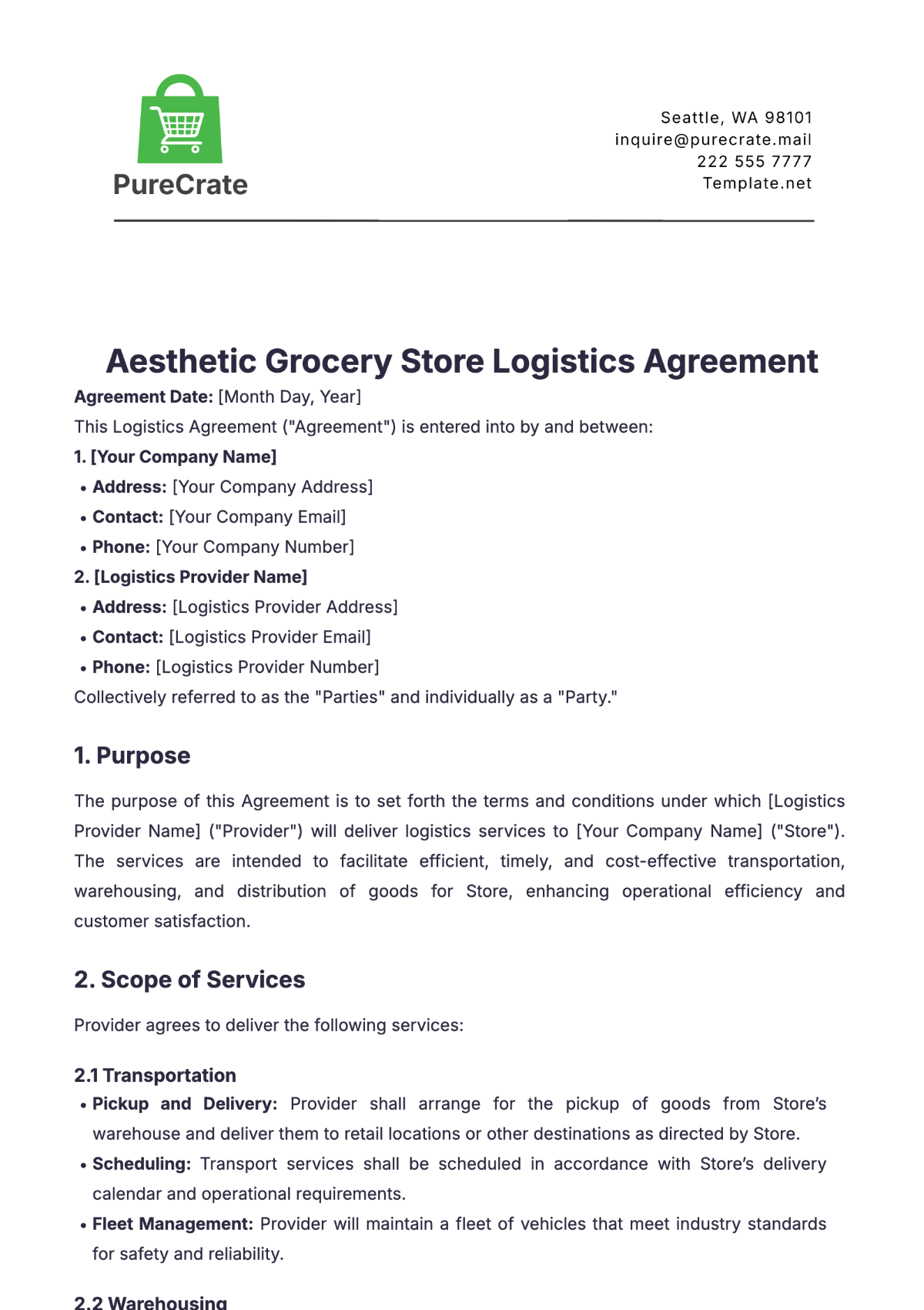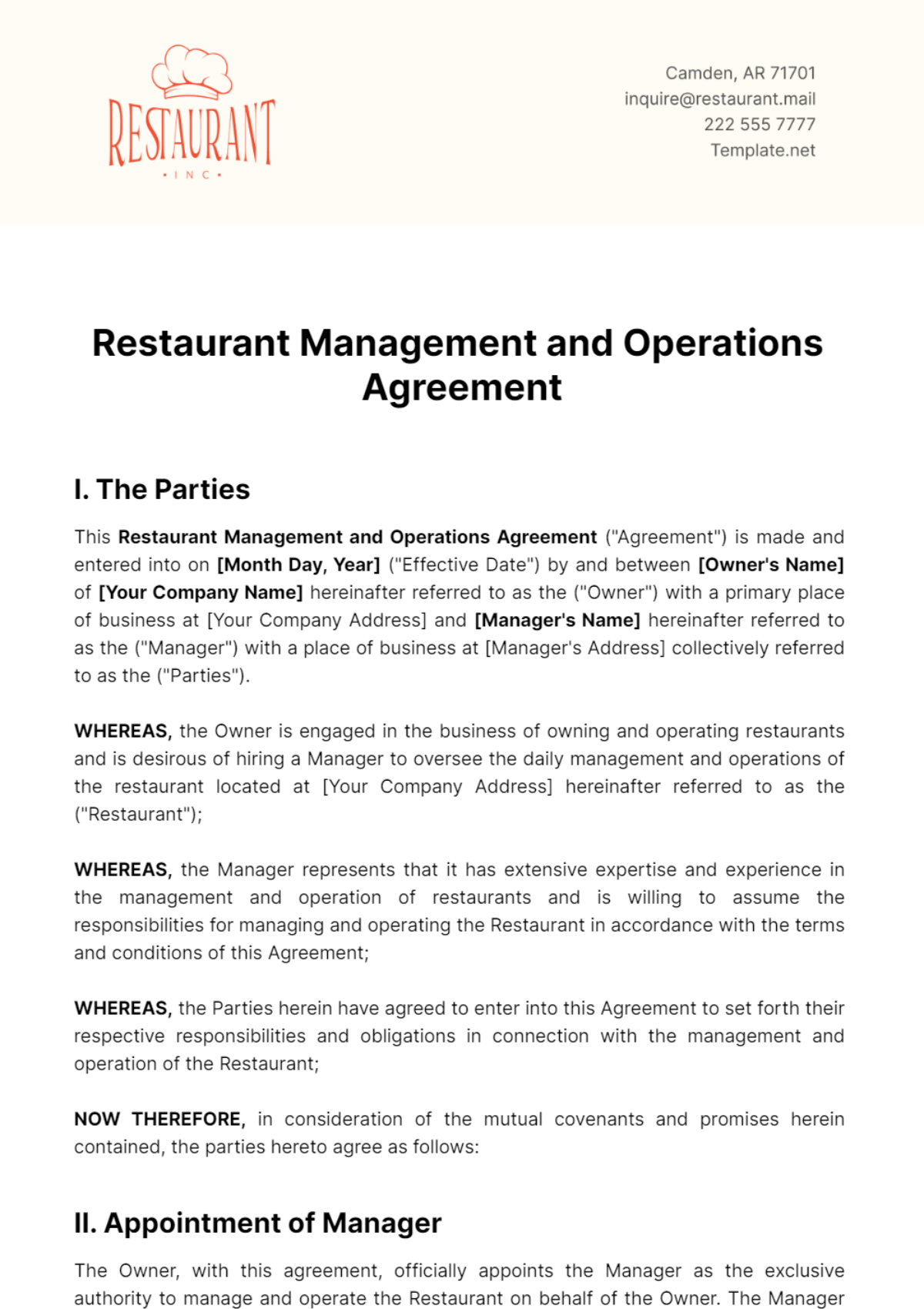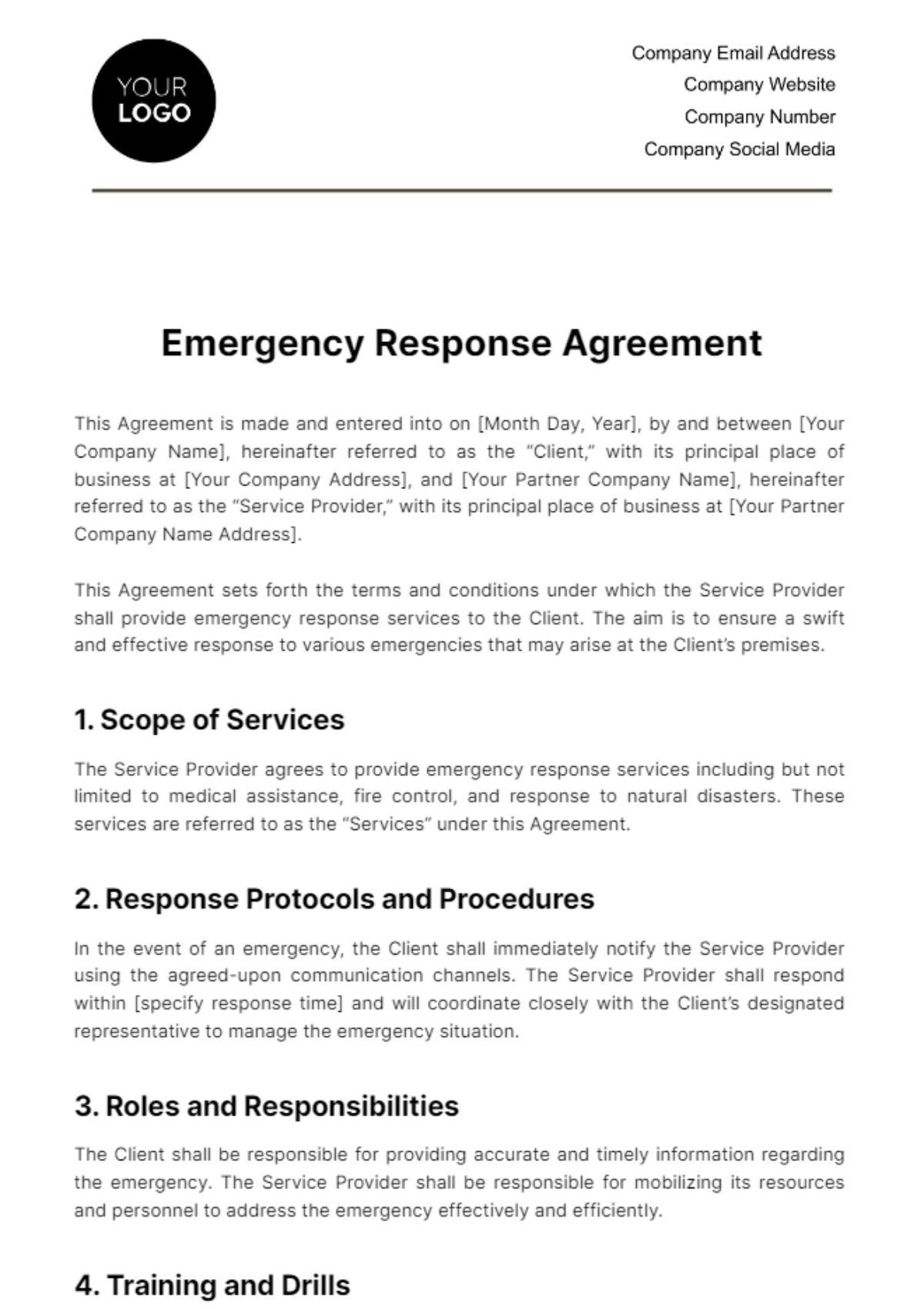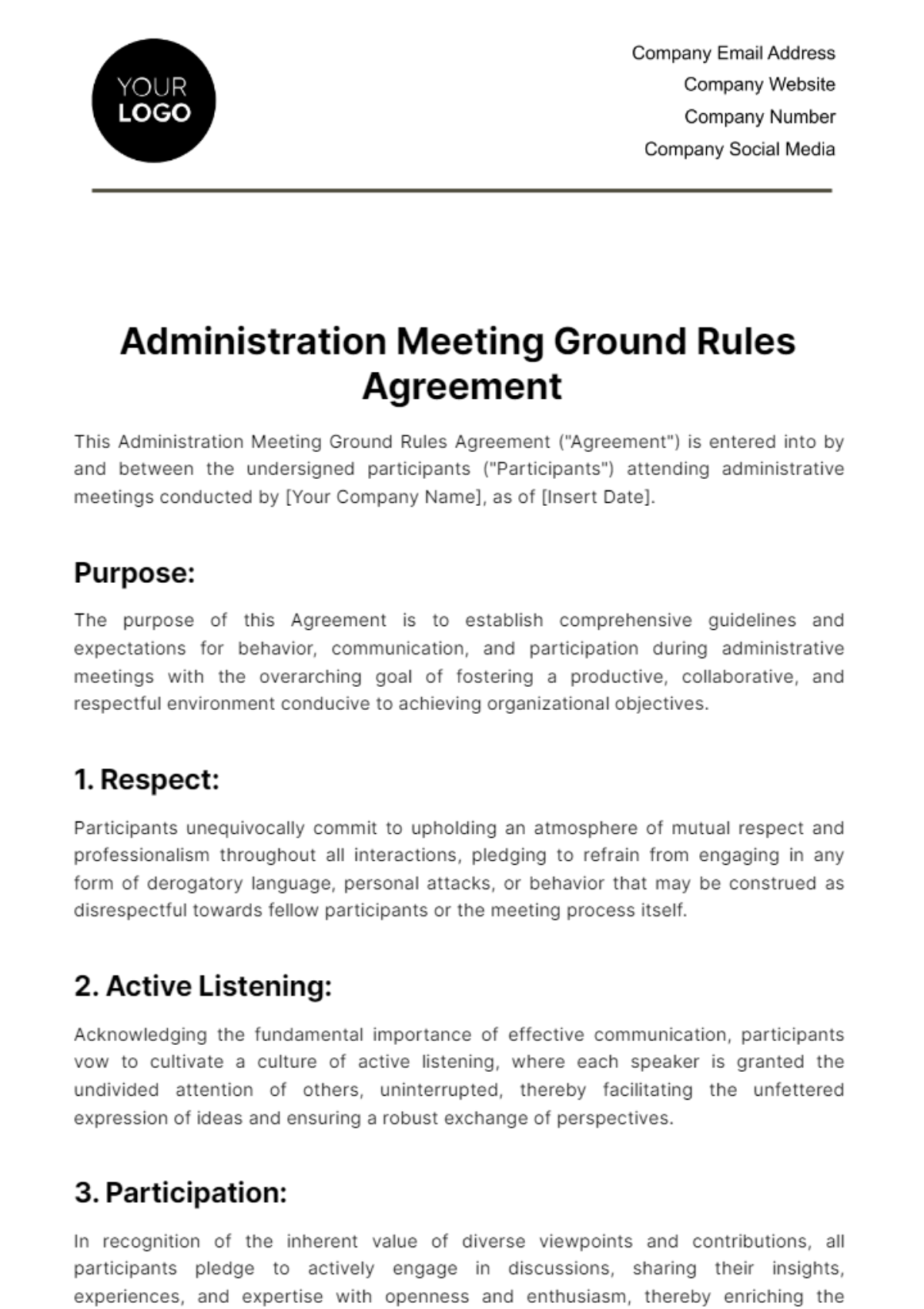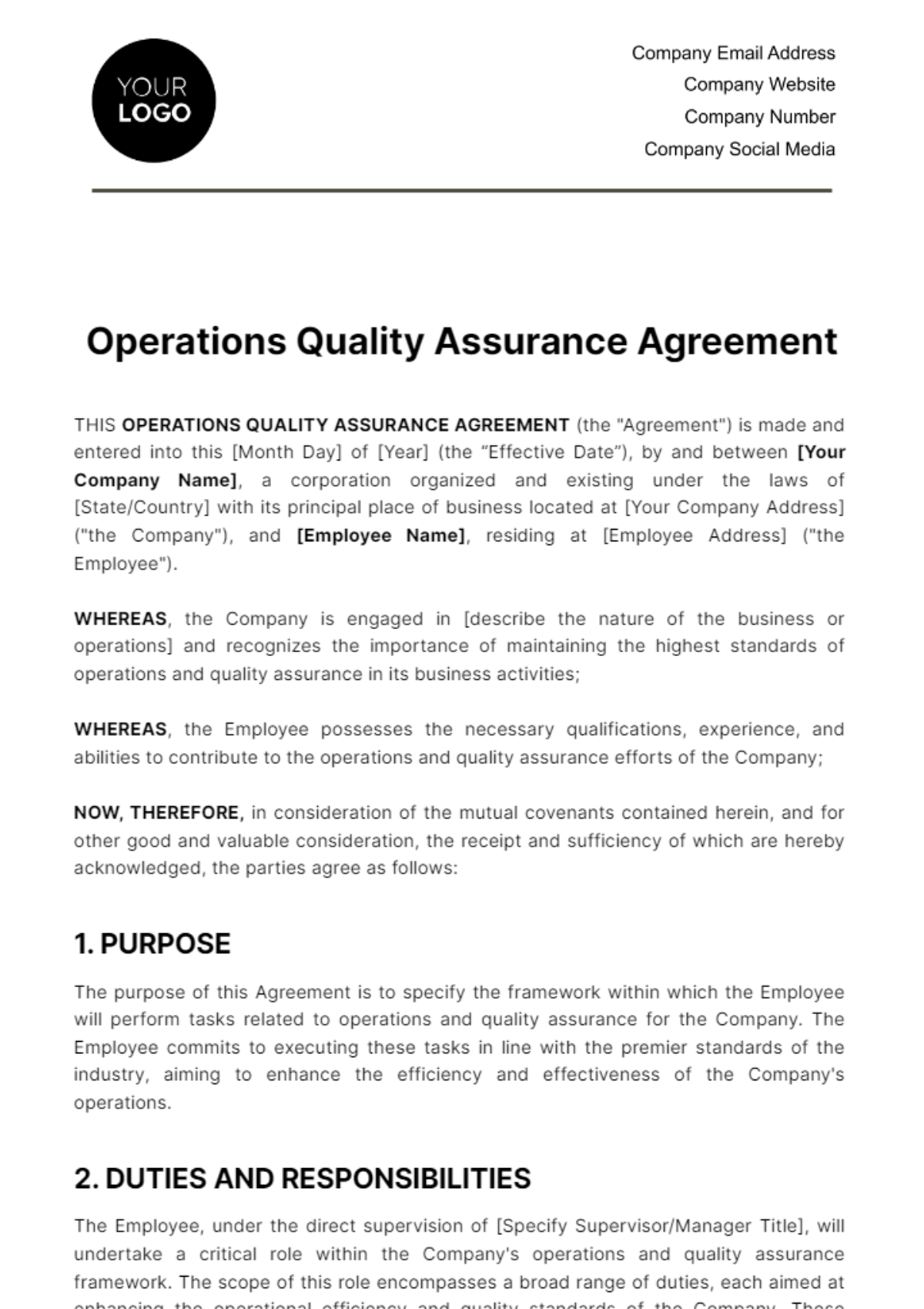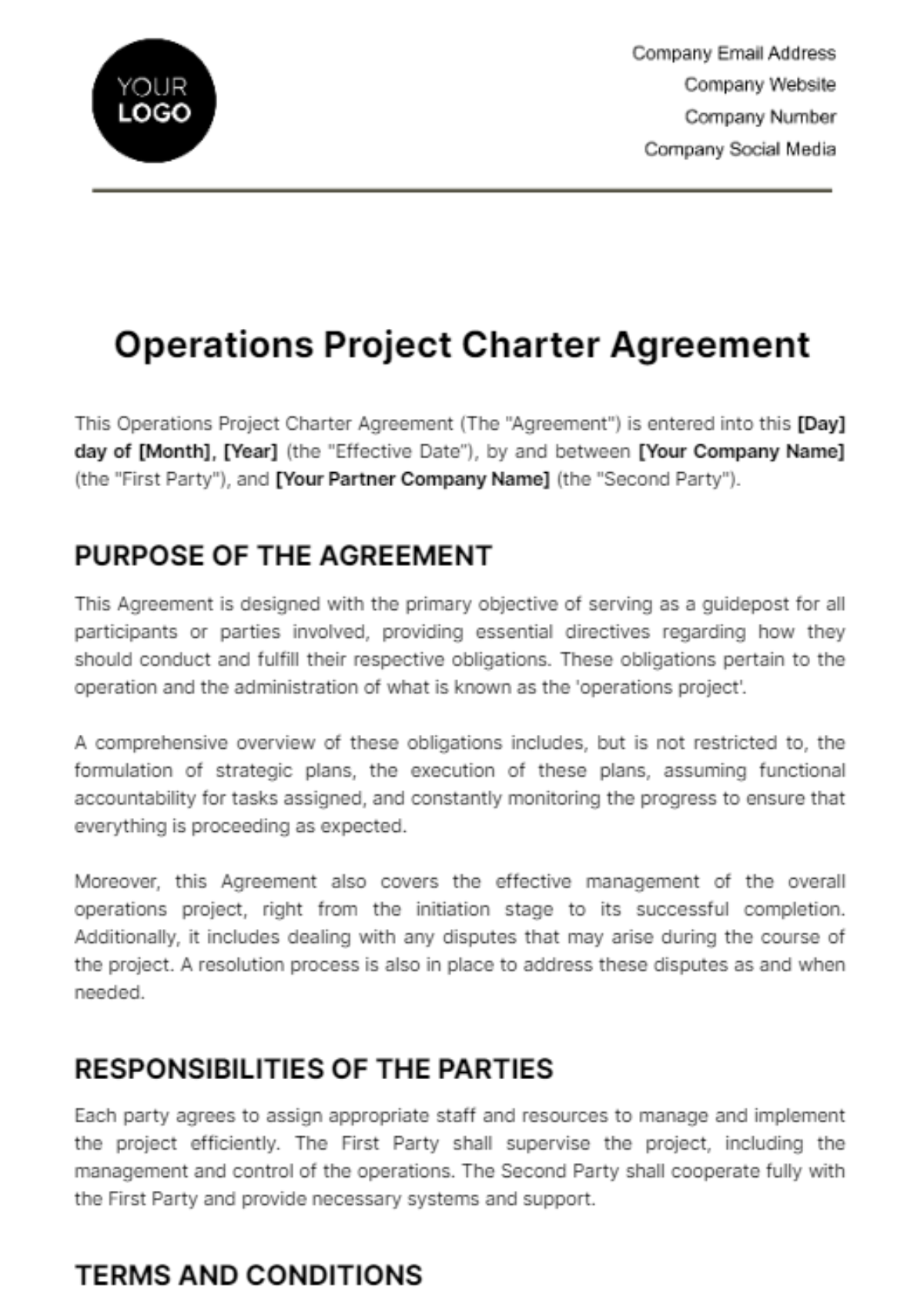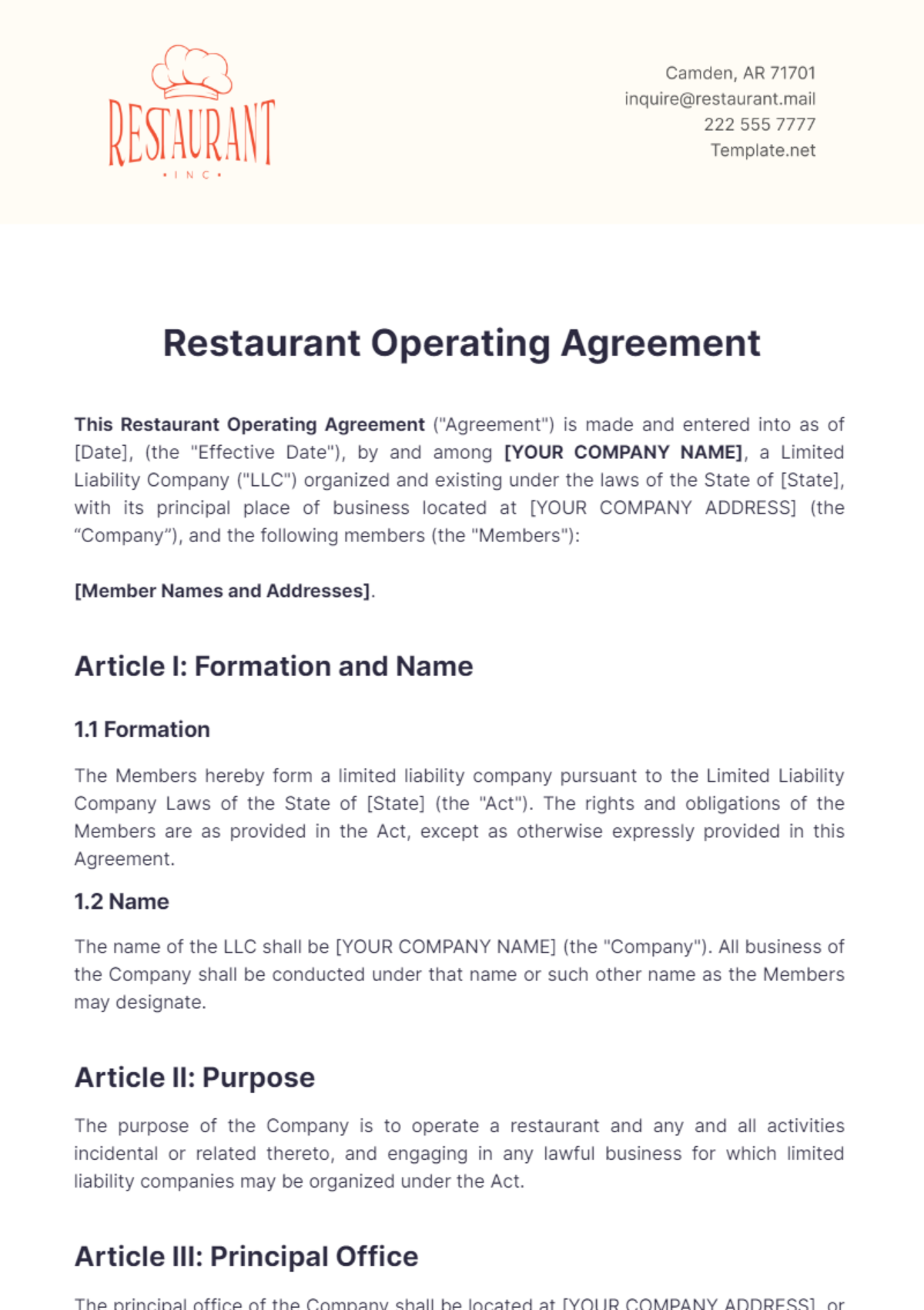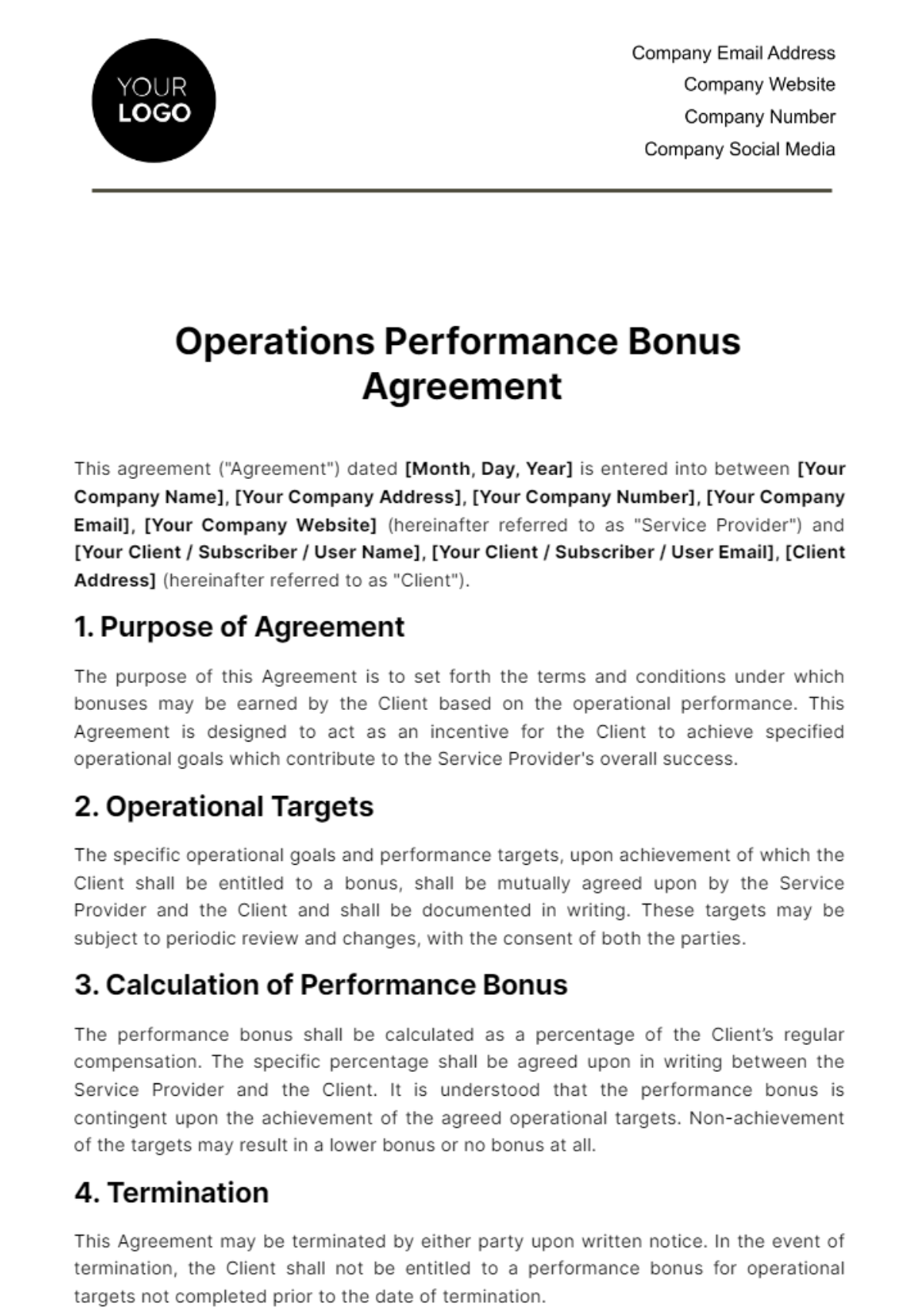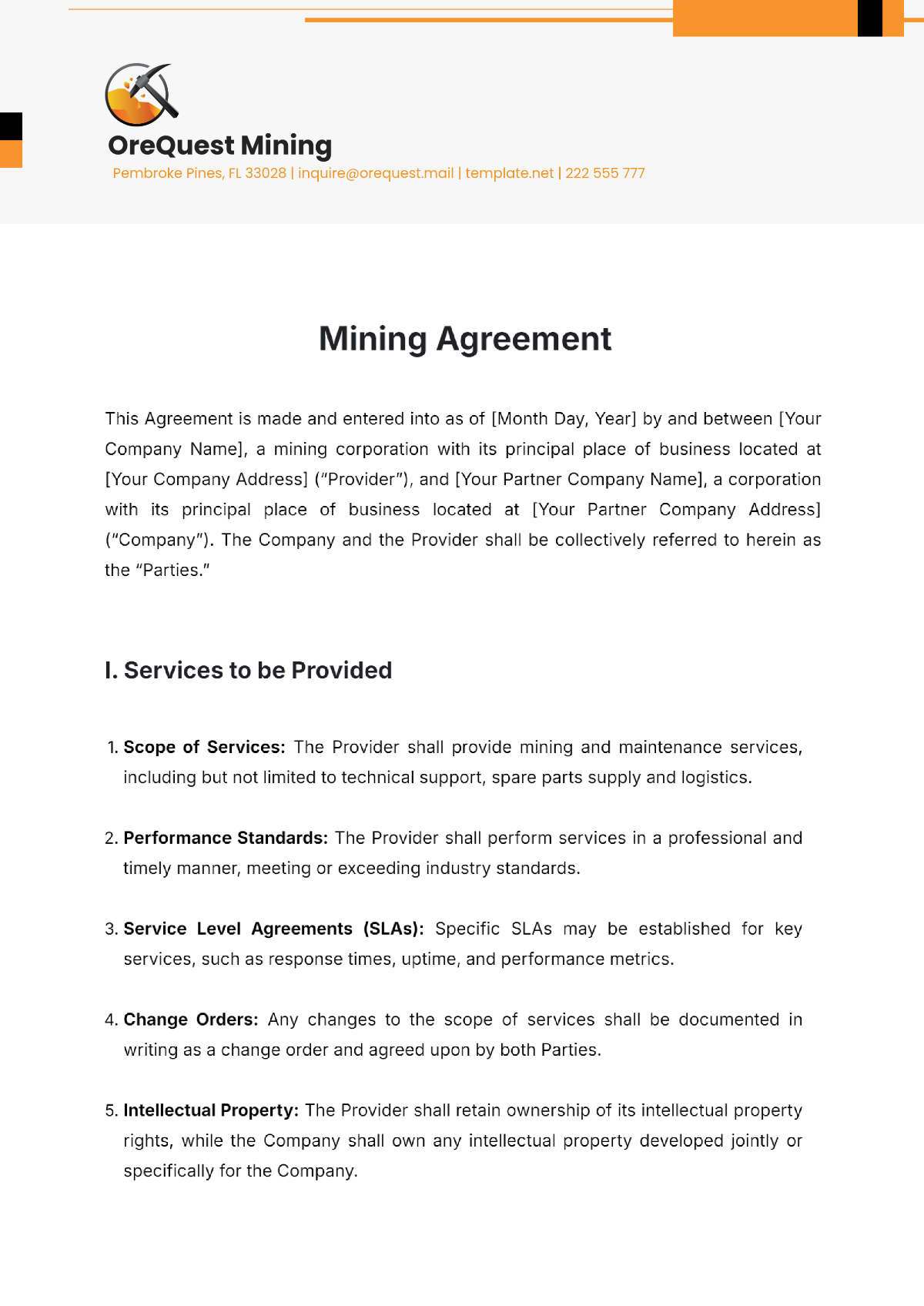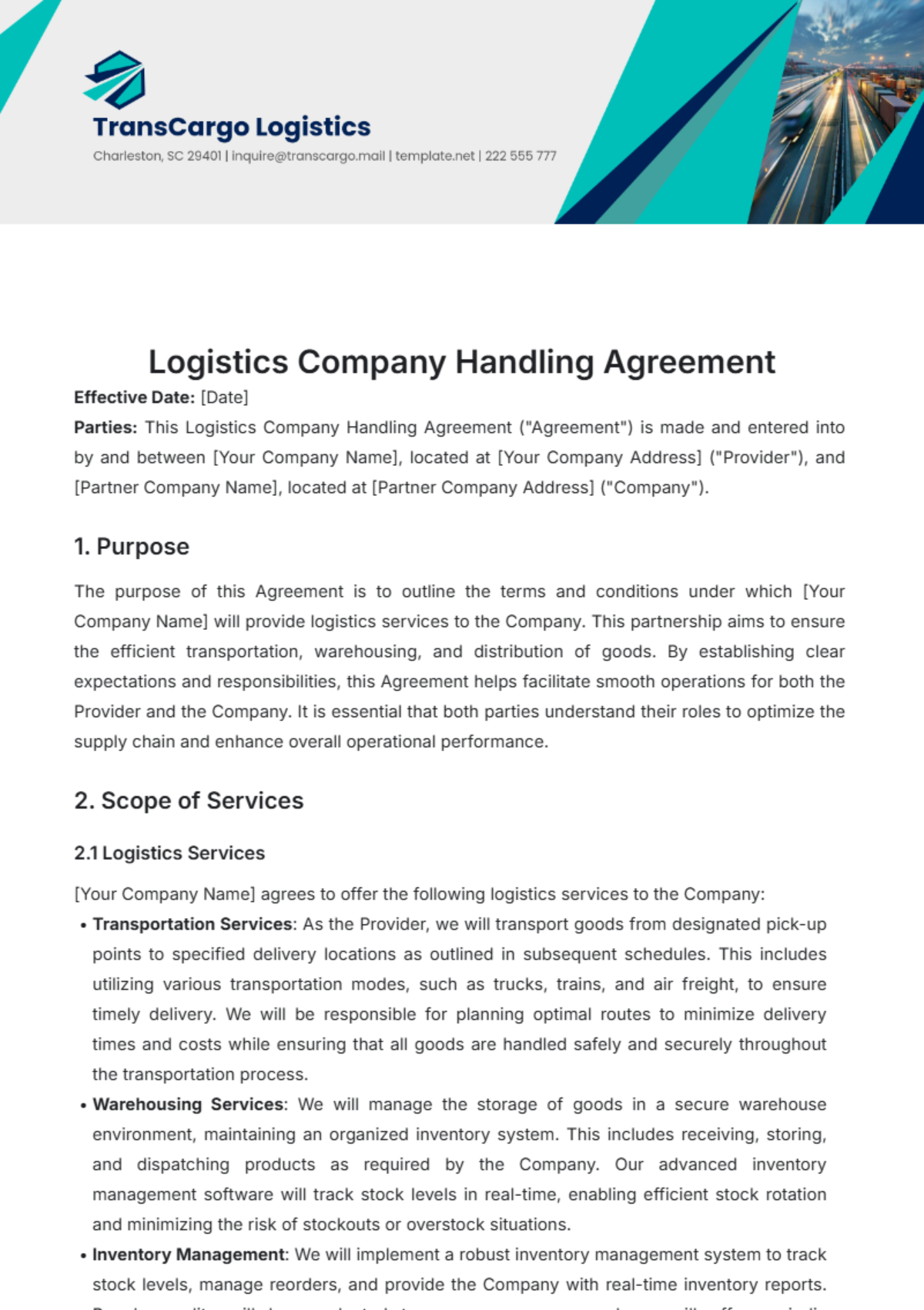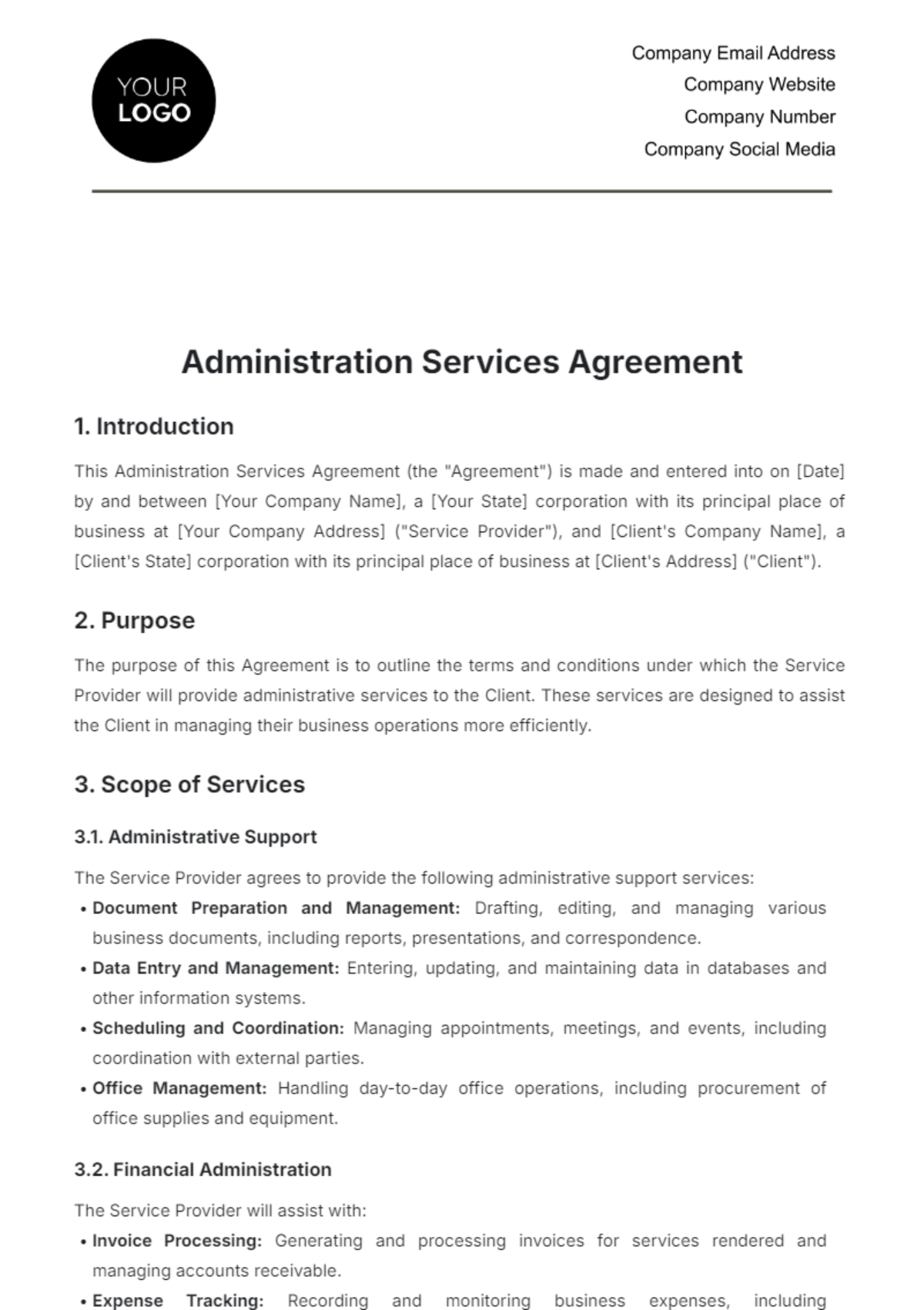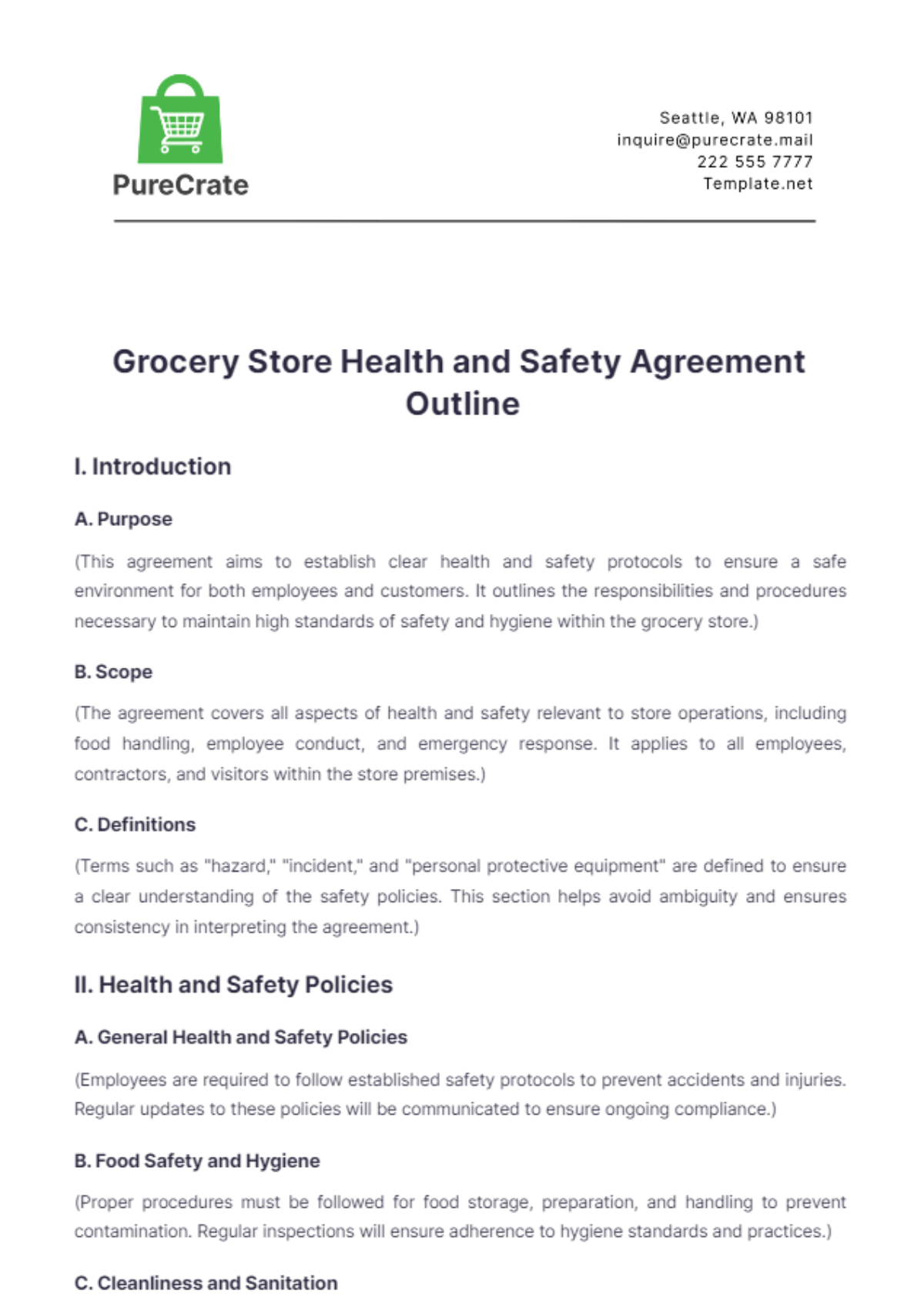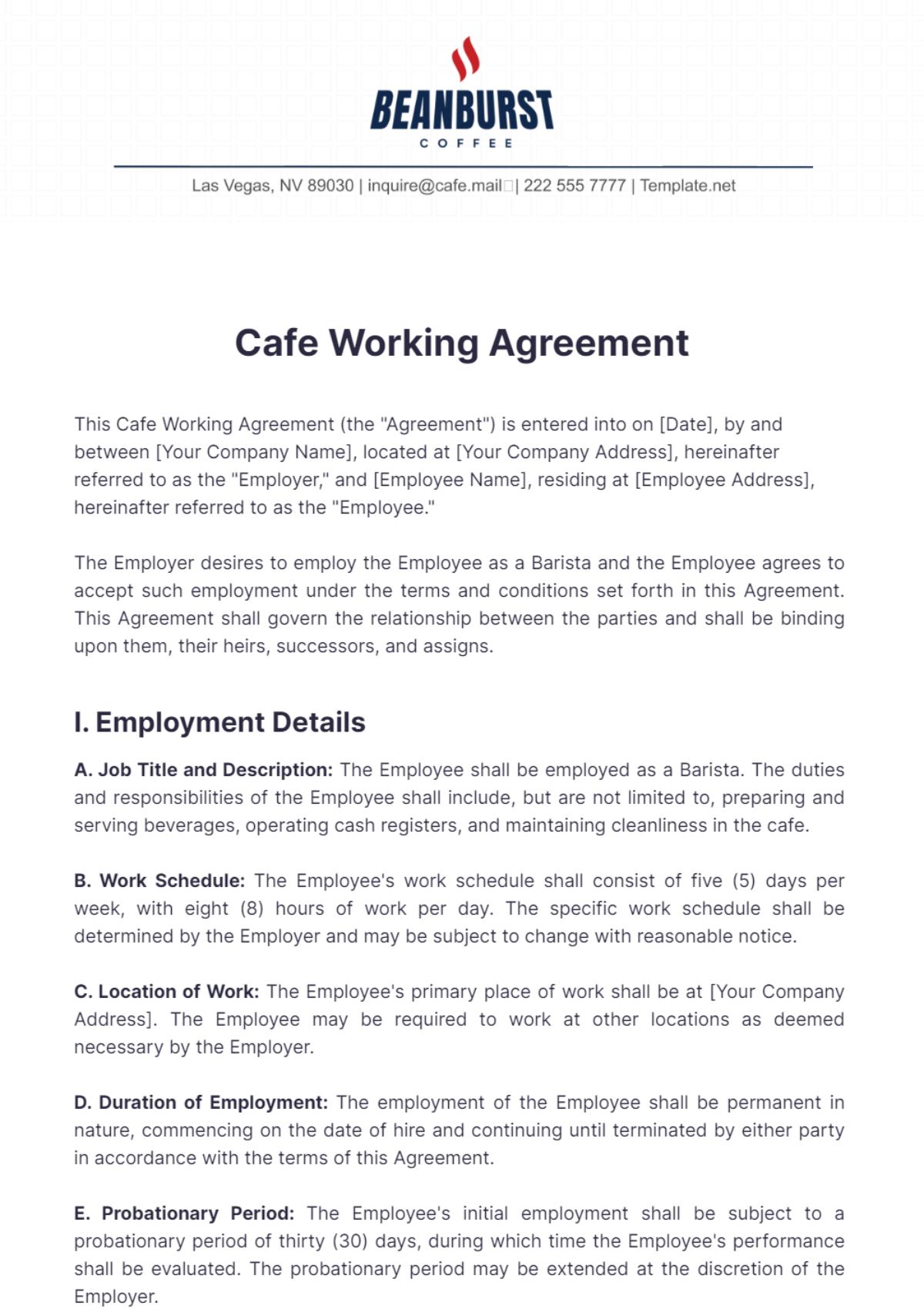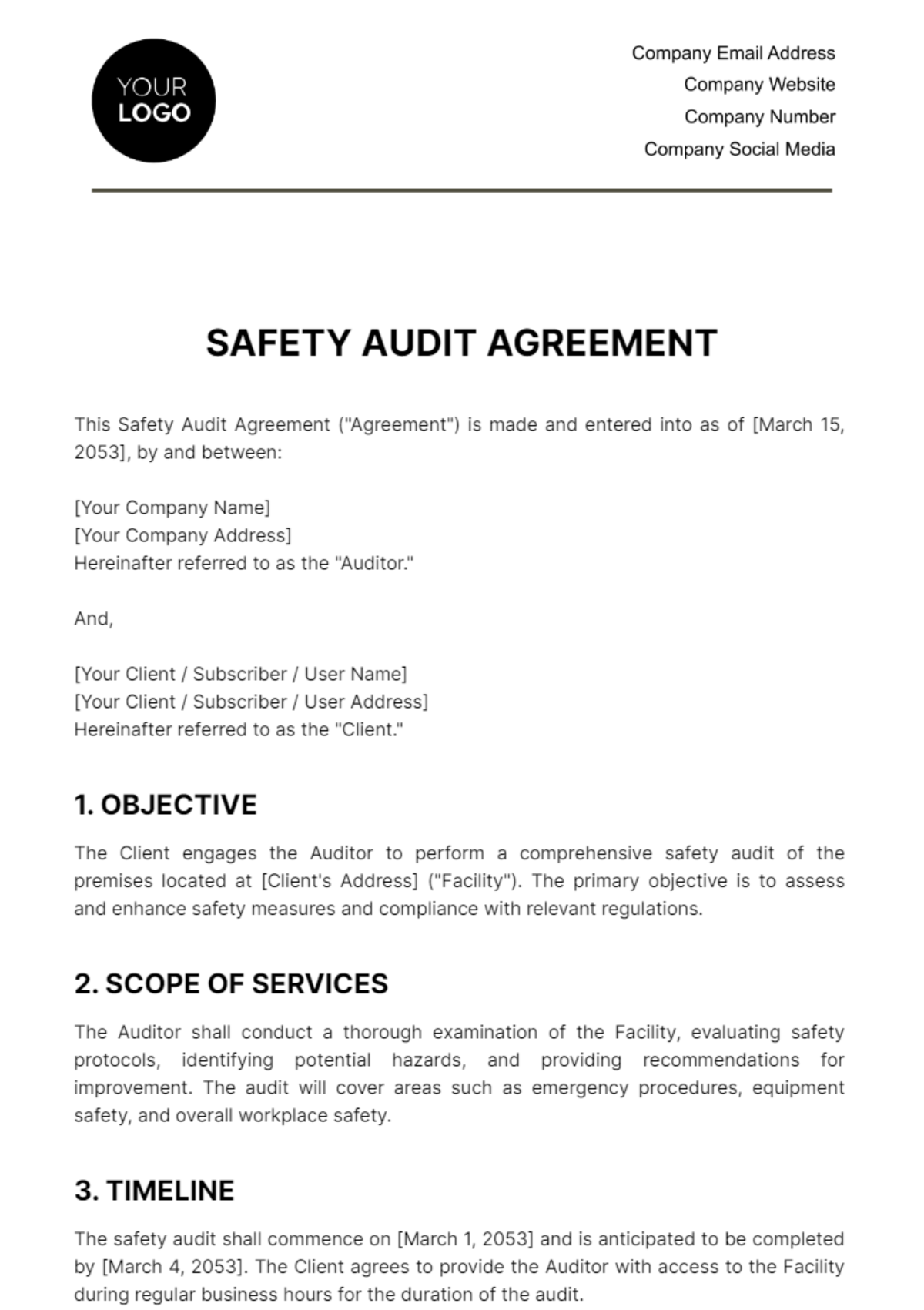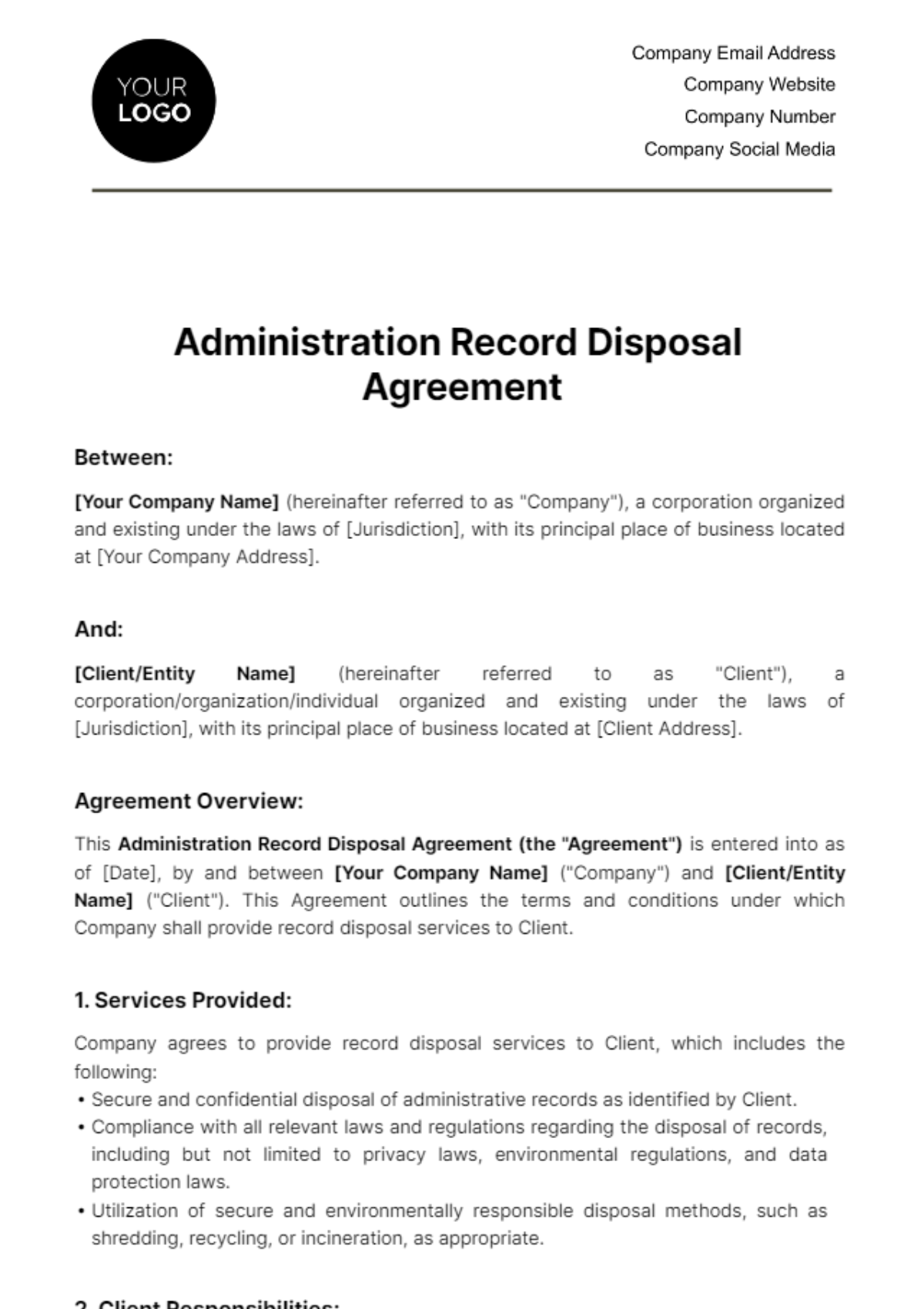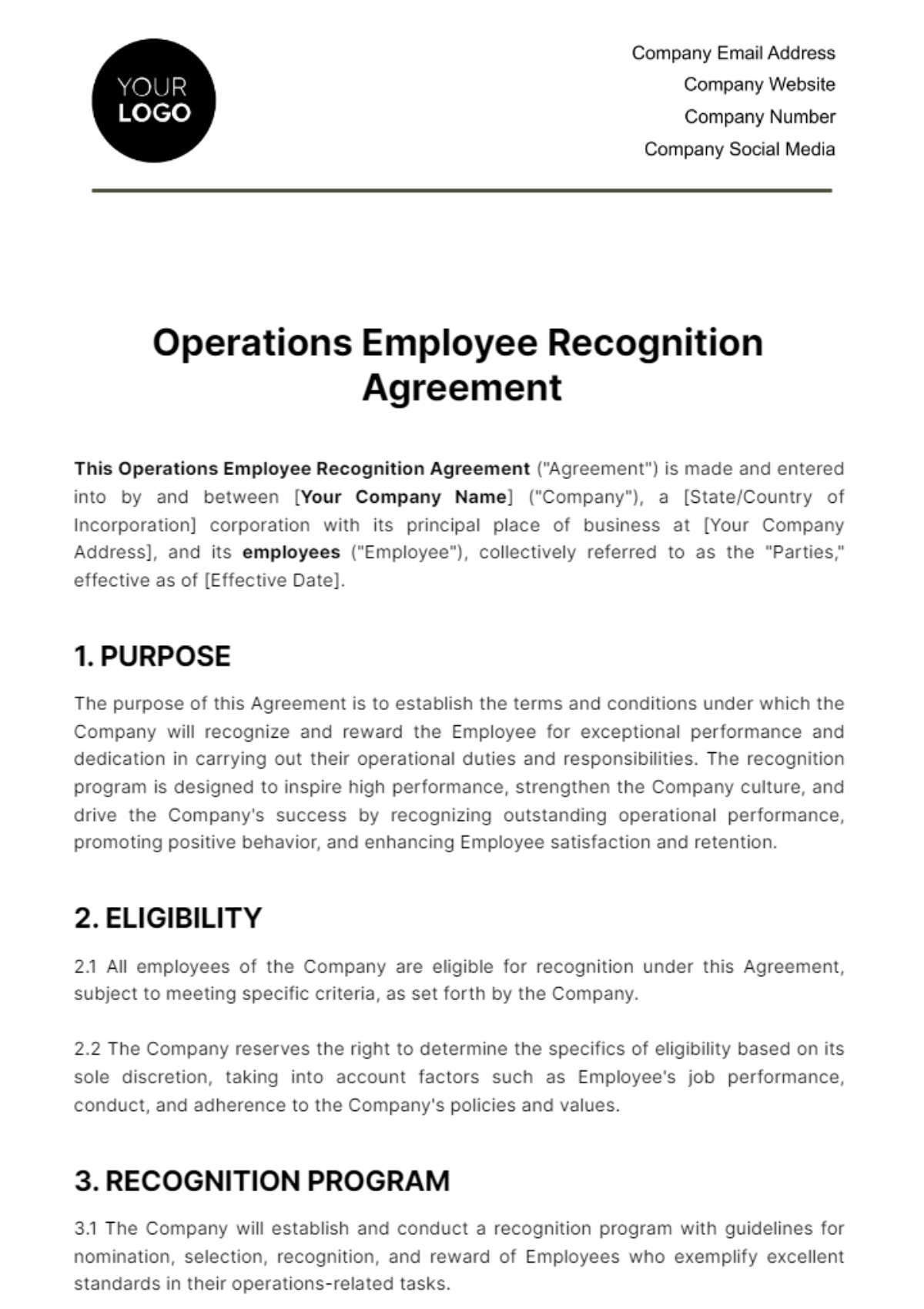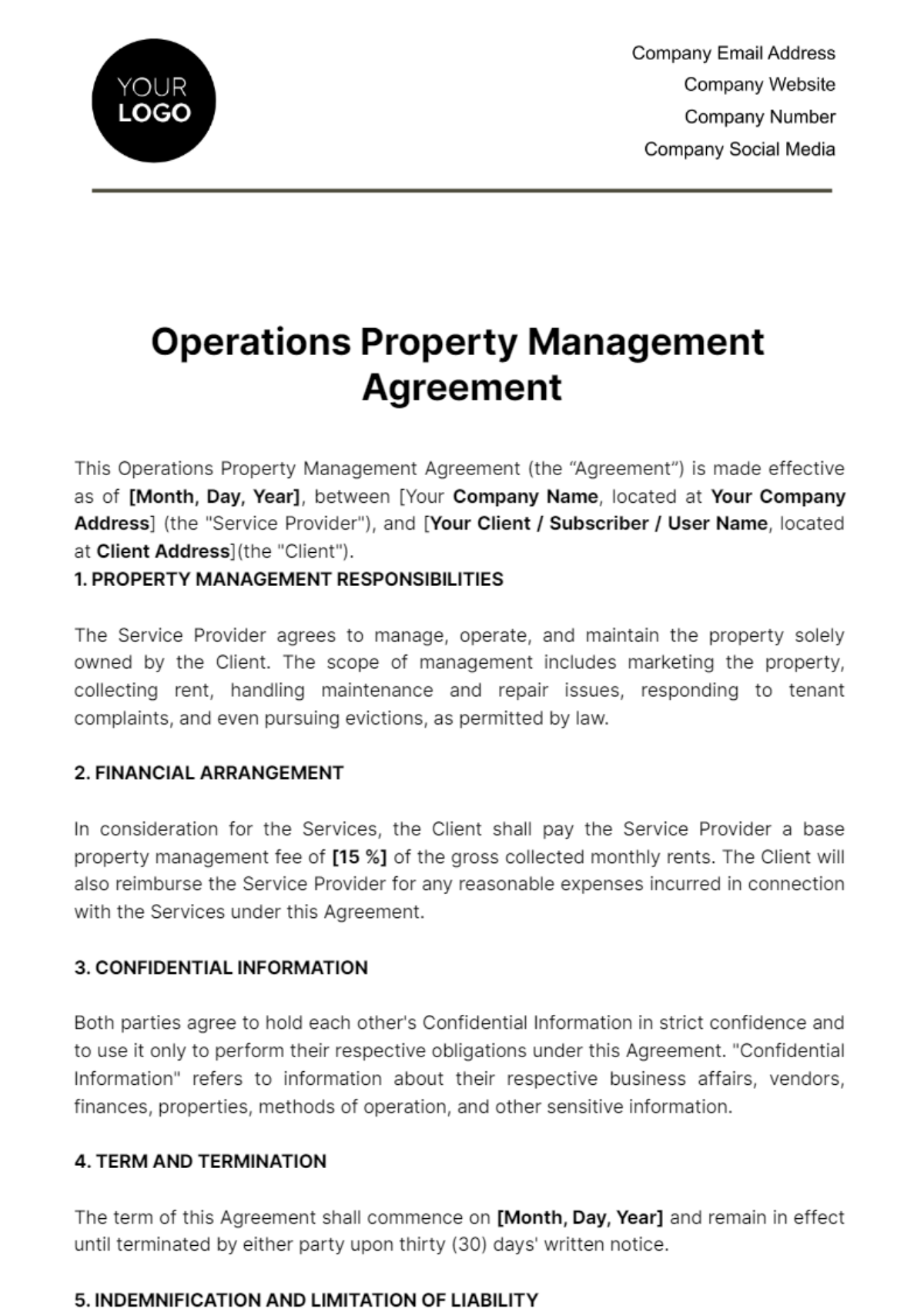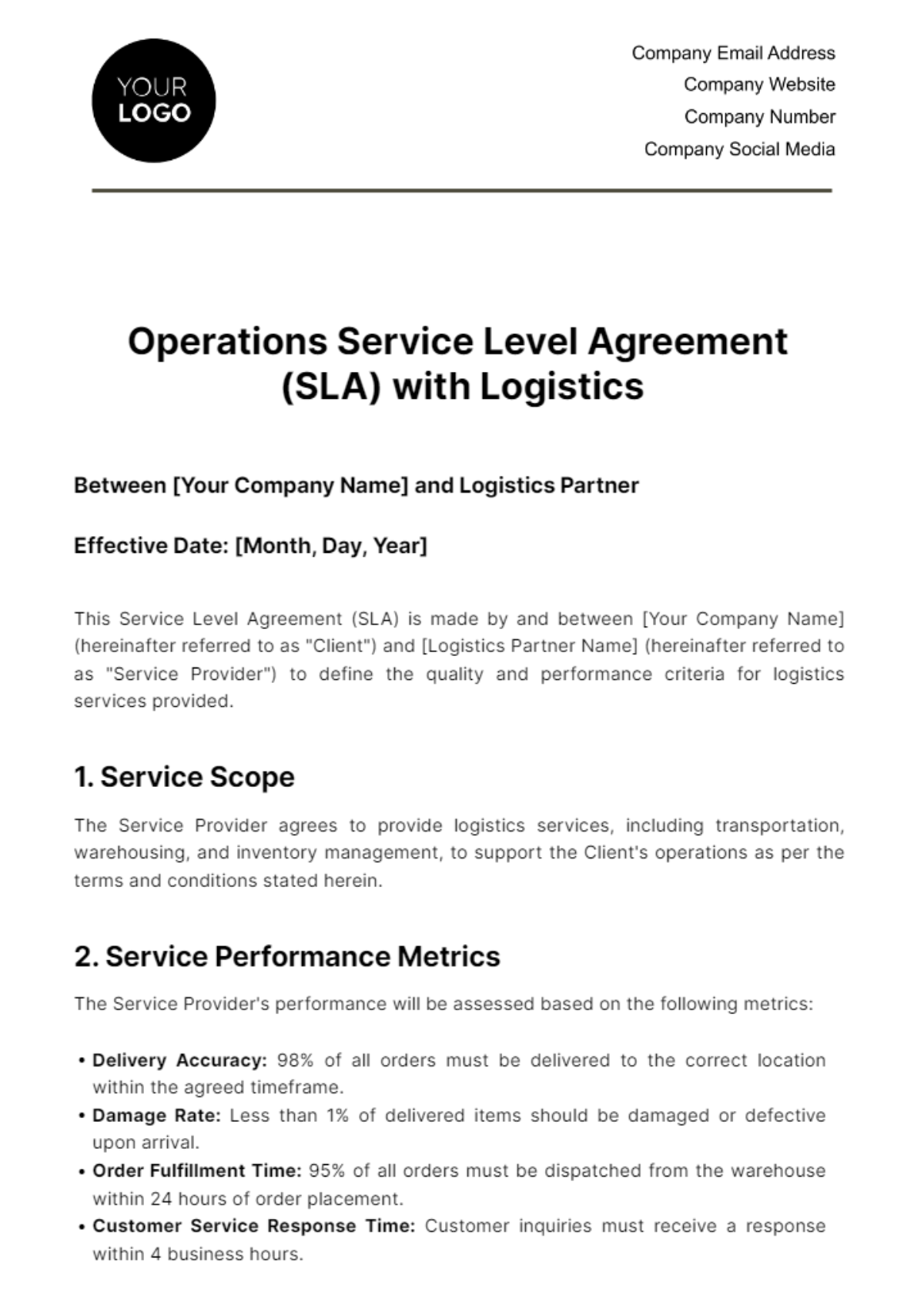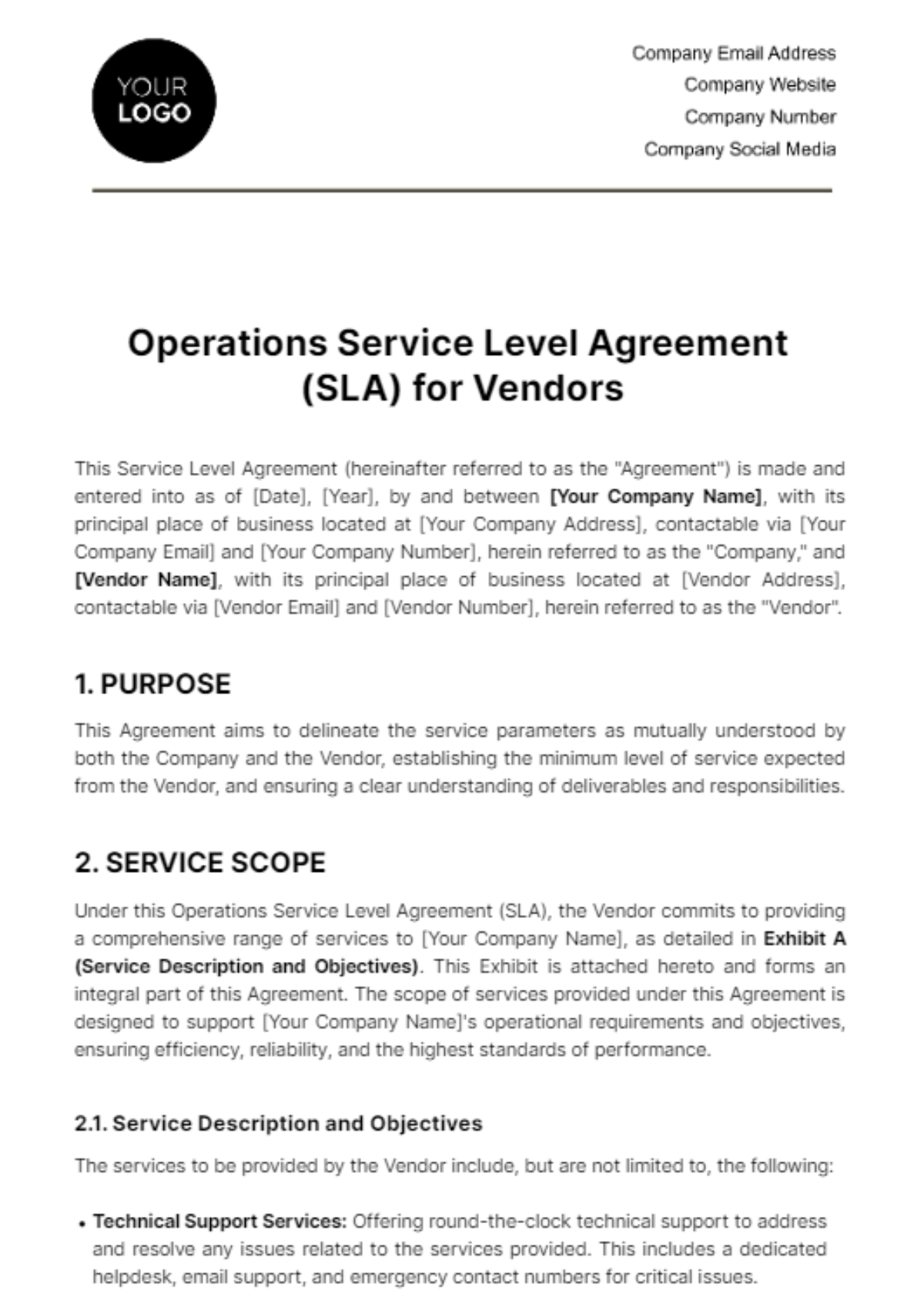Operations Logistics Service Level Agreement Plan
This Operations Logistics Service Level Agreement (SLA) Plan is established as of [Month Day, Year] (the “Effective Date”), by and between [Your Company Name], with its principal place of business located at [Your Company Address] ("Service Provider"), and [Your Partner Company Name / Second Party], with its principal place of business located at [Your Partner Company Name / Second Party Address] ("Client").
Table of Contents
1. Purpose
2. Services Provided
3. Service Levels
4. Duties and Responsibilities
5. Payment
6. Term and Termination
7. Governing Law
8. Agreement Execution
1. Purpose
The primary objective of this Service Level Agreement (SLA) is to formally articulate the specific requirements and expectations associated with the provision of operations and logistics services by [Your Company Name] (hereafter referred to as "Service Provider") to [Your Partner Company Name / Second Party] (hereafter referred to as "Client").
This SLA is crafted to ensure the delivery of services characterized by exemplary efficiency, reliability, and adherence to the highest quality standards. It is designed to establish a clear and mutual understanding of the performance criteria, thereby committing both parties to uphold the principles of excellence in logistical operations.
Through this agreement, the Service Provider and the Client pledge to maintain a cooperative and productive partnership, focused on optimizing supply chain efficiency and elevating the standard of operational execution. The dedication to these service delivery principles is critical in cultivating a durable and fruitful business relationship, grounded in mutual respect and shared goals.
2. Services Provided
Under the terms of this SLA, [Your Company Name], as the Service Provider, agrees to furnish a comprehensive array of operations and logistics services to the Client, consistent with the performance standards, responsibilities, metrics, and quality benchmarks stipulated within this document. The scope of services encompasses, but is not limited to:
Inventory Management: Implementing efficient strategies for stock control and order fulfillment.
Order Processing: Ensuring accurate and prompt processing of orders to meet customer demands.
Warehousing: Providing secure and efficient storage solutions for a variety of goods.
Distribution: Managing the logistics of goods distribution to ensure timely delivery.
Transportation Management: Overseeing the planning, execution, and optimization of goods transportation.
Customer Service: Offering professional support to address any inquiries or issues related to logistics services.
By utilizing advanced technologies, adhering to best practices in the industry, and deploying a team of seasoned logistics professionals, [Your Company Name] aims to deliver logistics solutions that are not only seamless and efficient but also cost-effective. The commitment to continuous monitoring and evaluation of service performance against established standards ensures that the Client’s logistics requirements are met with the utmost precision and professionalism.
3. Service Levels
This section delineates the Service Provider's commitment to achieving and sustaining a minimum service uptime of [XX]%, a critical measure designed to ensure the reliability and consistency of services delivered to the Client. Failure to adhere to this stipulated Service Level exposes the Service Provider to a series of remedies and penalties, as comprehensively detailed in Section 5 of this SLA.
3.1. Service Uptime Commitment
The Service Provider commits to a minimum service uptime of [XX]%, ensuring operational efficiency and reliability in the delivery of logistics and operations services. This commitment is central to the SLA, underscoring the Service Provider's dedication to excellence and reliability.
3.2. Monitoring and Management Protocols
The Service Provider has instituted a comprehensive framework of monitoring and management protocols aimed at ensuring the highest standards of service delivery. This framework is a testament to our commitment to operational excellence and client satisfaction. Below is an outline detailing the key components of our monitoring and management protocols:
3.2.1. Proactive Monitoring
Real-Time Surveillance: Continuous, 24/7 monitoring of all operations and logistics systems to detect anomalies or disruptions in real time.
Predictive Analytics: Utilization of predictive analytics tools to forecast potential issues based on historical data and trends, enabling preemptive action.
3.2.2. Incident Identification
Automated Alert Systems: Deployment of sophisticated alert systems that notify relevant teams of potential issues immediately upon detection.
Root Cause Analysis: Comprehensive analysis of any incidents to identify underlying causes, preventing recurrence.
3.2.3. Swift Rectification
Rapid Response Teams: Establishment of dedicated rapid response teams tasked with addressing and resolving incidents as quickly as possible.
Standard Operating Procedures (SOPs): Implementation of clear SOPs for incident management, ensuring consistent and efficient resolution processes.
3.2.4. Minimizing Impact
Contingency Planning: Development of robust contingency plans to maintain service continuity in the face of disruptions.
Client Communication Protocols: Transparent and timely communication with clients regarding any issues and the steps being taken for resolution.
3.2.5. Utilization of State-of-the-Art Technology
Advanced Software Solutions: Adoption of leading-edge software for logistics management, including Transportation Management Systems (TMS) and Warehouse Management Systems (WMS), to enhance operational efficiency.
Performance Analysis Tools: Use of performance analysis tools for ongoing assessment of service delivery metrics, identifying areas for improvement.
3.2.6. Continuous Performance Analysis
Regular Reporting: Generation of detailed performance reports for internal review and client updates, fostering a culture of transparency and continuous improvement.
Client Feedback Integration: Active solicitation and integration of client feedback into service delivery processes, ensuring services are aligned with client needs and expectations.
3.3. Remedies and Penalties
In the commitment to uphold the highest standards of service delivery, the Service Provider has established a structured framework for remedies and penalties to address any deviations from the agreed-upon service levels. This framework is integral to maintaining trust and accountability in our partnership with the Client. Below is an outline detailing the specific remedies and penalties that will be enacted in the event of a service level breach, where service uptime falls below the stipulated [XX]% threshold.
3.3.1. Financial Compensations
Direct Financial Compensation: In cases of significant service disruptions, the Client may be entitled to direct financial compensation, the amount of which is predetermined based on the severity and duration of the service breach.
Penalty Clauses: The SLA includes penalty clauses that specify monetary penalties for not meeting the agreed service levels, calculated as a percentage of the monthly service fee.
3.3.2. Service Credits
Credit Allocation: The Client will receive service credits equivalent to a portion of the monthly fees, which can be applied to future invoices. The value of these credits is proportional to the extent of the service shortfall.
Enhanced Service Credits: For repeated or severe service level breaches, the allocation of service credits may be increased as a further measure of compensation to the Client.
3.3.3. Enhanced Support Services
Priority Support: Immediate access to priority support services, including dedicated personnel and expedited response times, to address and resolve any issues arising from the service breach.
Additional Support Resources: Provision of extra support resources, such as increased access to technical consultants or additional training for the Client’s staff, to mitigate the impact of the breach and prevent future occurrences.
3.3.4. Performance Review Meetings
Scheduled Reviews: Implementation of scheduled performance review meetings following a service breach to discuss the root causes, impact, and preventive measures. These meetings facilitate direct communication between the Service Provider and the Client to ensure alignment and understanding.
Action Plan Development: Development of a detailed action plan outlining specific steps to address the issues identified and prevent future breaches. This plan is developed in collaboration with the Client to ensure it meets their needs and expectations.
3.3.5. Escalation Procedures
Formal Escalation Path: Establishment of a formal escalation path for service issues, ensuring that they are addressed promptly and by the appropriate levels of management.
Continuous Monitoring: Post-resolution, the service will be subject to increased monitoring for a defined period to ensure stability and performance are restored and maintained.
3.4. Approach to Service Level Management
The Service Provider adopts a holistic approach to managing service levels, which includes proactive risk management and the deployment of advanced technology to ensure robust and responsive service delivery. This comprehensive strategy is aimed at building and sustaining the Client's confidence in the Service Provider's capabilities.
3.5. Objective of Service Level Commitment
The primary objective of maintaining specified service levels is to foster trust and dependability in the partnership with the Client, contributing significantly to the success of the Client's business operations. This commitment is a testament to the Service Provider's dedication to continuous improvement and excellence in service delivery.
4. Duties and Responsibilities
The Service Provider, [Your Company Name], pledges to uphold the highest levels of professionalism, skill, and expertise in the delivery of operations and logistics services. This encompasses a broad spectrum of responsibilities:
Comprehensive Service Management: Ensuring efficient and effective management of all logistics and operations services, including inventory management, transportation, warehousing, and customer service.
Quality Assurance: Adhering to the highest industry standards to maintain the quality and reliability of services provided.
Innovation and Improvement: Utilizing state-of-the-art technology and innovative processes to continually enhance service delivery.
Professional Team: Deploying a team of highly skilled professionals committed to executing their duties with excellence and precision.
Proactive Problem-Solving: Employing a proactive approach to identifying and resolving potential issues before they impact the Client.
Adherence to Best Practices: Following industry best practices to ensure services are delivered efficiently, effectively, and safely.
[Your Company Name]'s dedication to these responsibilities demonstrates a steadfast commitment to enhancing [Your Partner Company Name / Second Party]'s operational capabilities and contributing significantly to their growth and success.
5. Payment
For the operations and logistics services provided, [Your Partner Company Name / Second Party] agrees to a payment structure as follows:
Payment Amount: A total sum of [Amount in Words] ([Currency Symbol][Amount]), payable according to the agreed schedule ([monthly/quarterly/annually]).
Timeliness of Payments: Emphasis on the importance of timely payments to facilitate uninterrupted service delivery.
Interest on Late Payments: Late payments will incur an interest charge, detailed in a subsequent agreement, to incentivize prompt payment and maintain a healthy financial relationship between the parties.
This payment agreement is designed to ensure that [Your Company Name] can continue to provide high-quality services without financial disruptions, fostering a stable and mutually beneficial partnership with [Your Partner Company Name / Second Party].
6. Term and Termination
The Service Level Agreement (SLA) is designed to establish a clear framework for the duration of the agreement and the conditions under which it may be terminated. This ensures both parties have a mutual understanding of the commitment and the circumstances that could lead to the dissolution of the agreement.
6.1. Term
Commencement Date: The SLA will take effect on [Start Date], marking the beginning of the service provision by [Your Company Name] to [Your Partner Company Name / Second Party].
Automatic Renewal: The agreement is structured to automatically renew on an annual basis, ensuring a continuous and seamless provision of services without the need for annual renegotiation, unless otherwise indicated by either party.
Notice for Non-renewal: Either party desiring not to renew the agreement must provide a written notice at least [60] days before the end of the current term, allowing both parties adequate time to prepare for the transition.
6.2. Termination
Immediate Termination for Material Breach: In the event of a material breach of the SLA terms by either party, the aggrieved party has the right to terminate the agreement immediately. A material breach includes, but is not limited to, failure to meet service levels, non-payment, and violation of confidentiality obligations.
Procedure for Termination: The party intending to terminate the agreement must provide written notice to the other party, detailing the nature of the breach and, if applicable, the period within which the breach can be remedied.
Remedy Period: If a remedy period is applicable, the breaching party will have [specified period] days from the receipt of the termination notice to address and remedy the breach. Failure to remedy within this period will result in automatic termination of the SLA.
Consequences of Termination: Upon termination, [Your Partner Company Name / Second Party] is required to settle any outstanding payments due to [Your Company Name] for services rendered up to the date of termination. Both parties must also return any materials, confidential information, and property belonging to the other party.
6.3. Post-Termination Obligations
Confidentiality: The obligation of confidentiality regarding any proprietary or sensitive information shared during the term of the SLA will survive the termination of the agreement, ensuring ongoing protection of both parties' intellectual property and business interests.
Final Settlement: A final settlement clause may be included to address the handling of any unresolved issues or financial obligations at the time of termination, ensuring a clear and equitable resolution.
7. Governing Law
This SLA and its interpretation, and any disputes arising hereunder, shall be governed by and construed in accordance with the laws of [Governing State/Country], without regard to its conflict of laws principles.
8. Agreement Execution
This SLA, including its terms and conditions, represents the entire agreement between the parties with respect to the subject matter hereof and supersedes all prior agreements, whether written or oral.
IN WITNESS WHEREOF, the parties hereto have executed this Service Level Agreement as of the Effective Date.
[Your Company Name]
Signature: [Your Signature]
Name: [Your Name]
Title: [Your Job Title]
Date: [Date]
[Your Partner Company Name / Second Party]
Signature: [Signature]
Name: [Your Client Representative]
Title: [Job Title]
Date: [Date]
